

Borobudur
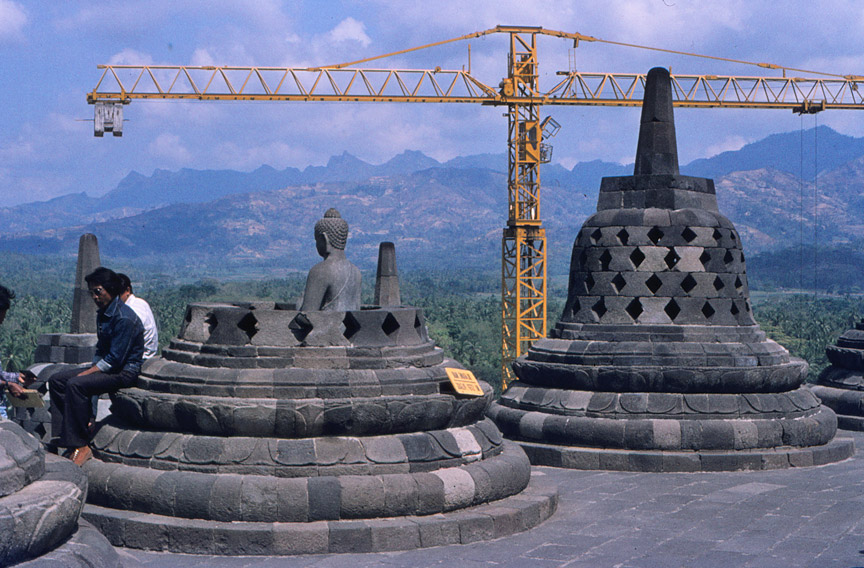
Borobudur
Borobudur is a ninth-century Mahayana Buddhist monument in Magelang, Central Java, Indonesia. The monument comprises six square platforms topped by three circular platforms, and is decorated with 2,672 relief panels and 504 Buddha statues. A main dome, located at the center of the top platform, is surrounded by 72 Buddha statues seated inside perforated stupa.

The monument is both a shrine to the Lord Buddha and a place for Buddhist
pilgrimage. The journey for pilgrims begins at the base of the monument and
follows a path circumambulating the monument while ascending to the top through
the three levels of Buddhist cosmology, namely Kamadhatu (the world of desire),
Rupadhatu (the world of forms) and Arupadhatu (the world of formlessness).
During the journey the monument guides the pilgrims through a system of
stairways and corridors with 1,460 narrative relief panels on the wall and the
balustrades.
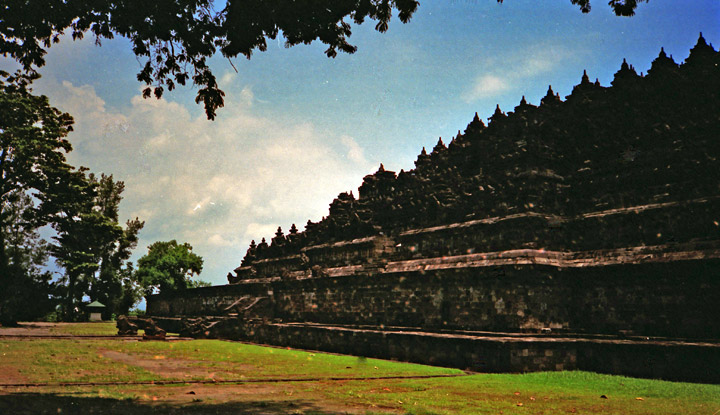
Evidence suggests Borobudur was abandoned following the fourteenth century
decline of Buddhist and Hindu kingdoms in Java, and the Javanese conversion to
Islam. Worldwide knowledge of its existence was sparked in 1814 by Sir Thomas
Stamford Raffles, the then British ruler of Java, who was advised of its
location by native Indonesians. Borobudur has since been preserved through
several restorations. The largest restoration project was undertaken between
1975 and 1982 by the Indonesian government and UNESCO, following which the
monument was listed as a UNESCO World Heritage Site. Borobudur is still used
for pilgrimage; once a year Buddhists in Indonesia celebrate Vesak at the
monument, and Borobudur is Indonesia's single most visited tourist attraction.
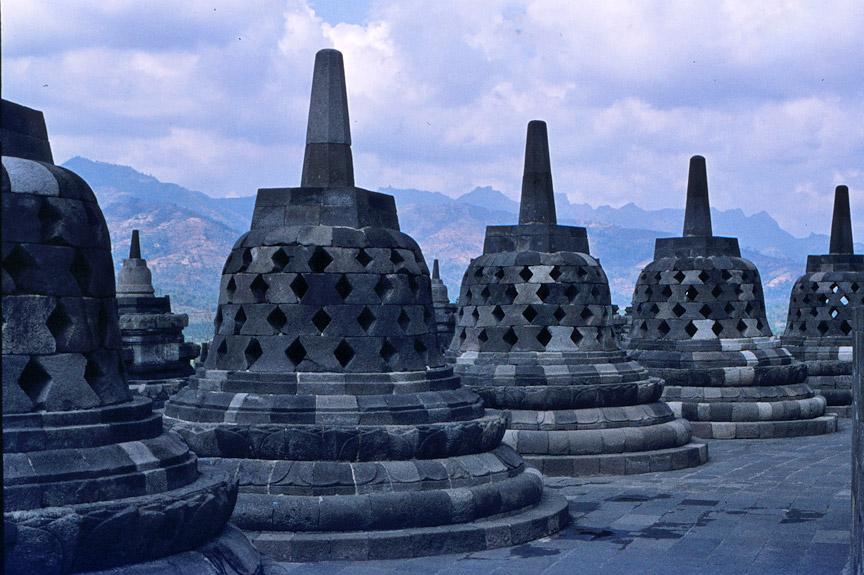
In Indonesian, ancient temples are known as candi; thus "Borobudur Temple" is
locally known as Candi Borobudur. The term candi is also used more loosely to
describe any ancient structure, for example gates and bathing structures. The
origins of the name Borobudur however are unclear, although the original
names of most ancient Indonesian temples are no longer known. The name Borobudur was first written in Sir Thomas Raffles' book on Javan history.
Raffles wrote about a monument called borobudur, but there are no older
documents suggesting the same name. The only old Javanese manuscript that
hints at the monument as a holy Buddhist sanctuary is Nagarakertagama, written
by Mpu Prapanca in 1365.
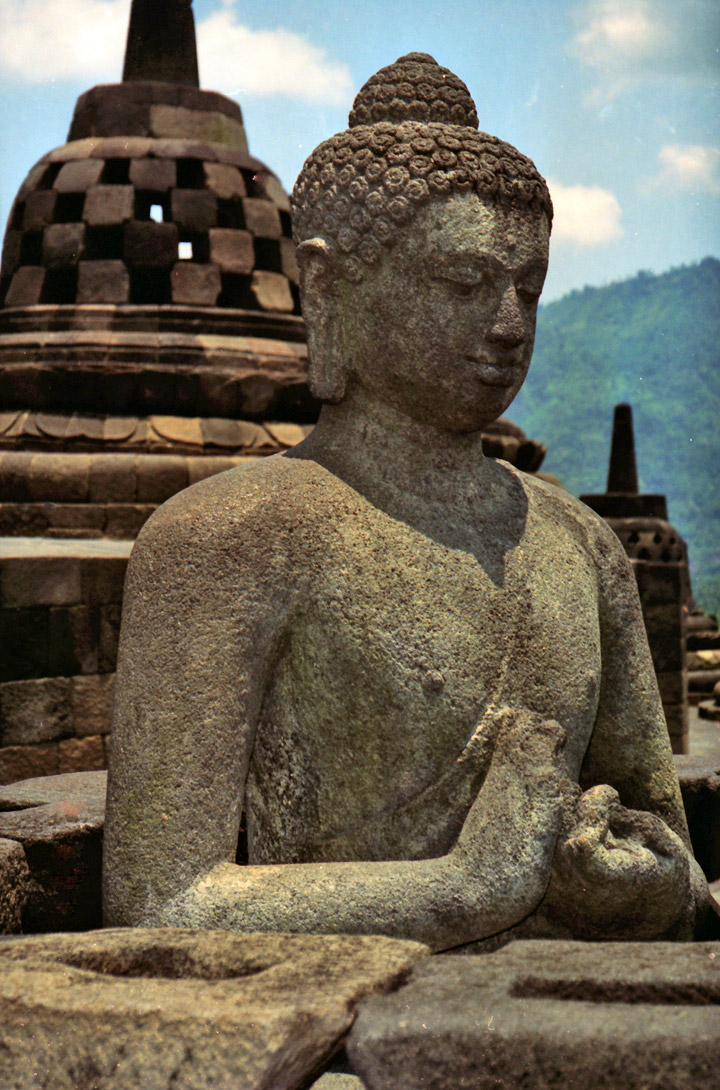
The name 'Bore-Budur', and thus 'BoroBudur', is thought to have been written by
Raffles in English grammar to mean the nearby village of Bore; most candi are
named after a nearby village. If it followed Javanese language, the monument
should have been named 'BudurBoro'. Raffles also suggested that 'Budur' might
correspond to the modern Javanese word Buda ('ancient') – i.e., 'ancient Boro'.
However, another archaeologist suggests the second component of the name ('Budur')
comes from Javanese term bhudhara (or mountain).
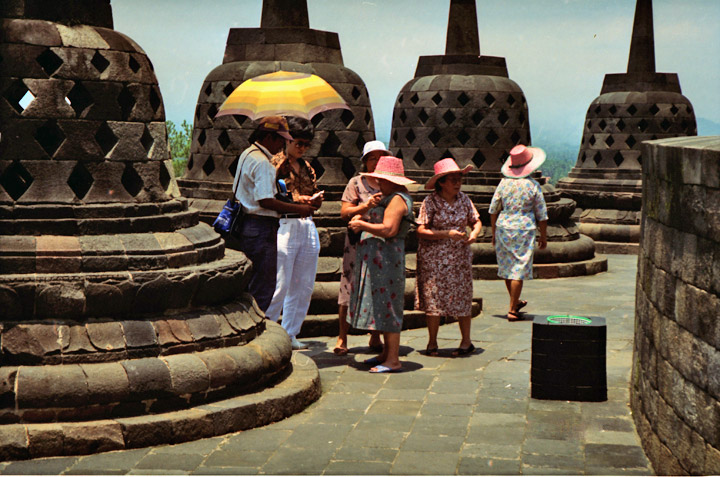
Approximately 40 kilometers (25 mi) northwest of Yogyakarta, Borobudur is
located in an elevated area between two twin volcanoes, Sundoro-Sumbing and
Merbabu-Merapi, and two rivers, the Progo and the Elo. According to local myth,
the area known as Kedu Plain is a Javanese 'sacred' place and has been dubbed
'the garden of Java' due to its high agricultural fertility. Besides Borobudur, there are other Buddhist and Hindu temples in the area, including the
Prambanan temples compound. During the restoration in the early 1900s, it was
discovered that three Buddhist temples in the region, Borobudur, Pawon and
Mendut, are lined in one straight line position. It might be accidental, but
the temples' alignment is in conjunction with a native folk tale that a long
time ago, there was a brick-paved road from Borobudur to Mendut with walls on
both sides. The three temples (Borobudur–Pawon–Mendut) have similar architecture
and ornamentation derived from the same time period, which suggests that ritual
relationship between the three temples, in order to have formed a sacred unity,
must have existed, although exact ritual process is yet unknown.

Unlike other temples, which were built on a flat surface, Borobudur was built on
a bedrock hill, 265 m (869 ft) above sea level and 15 m (49 ft) above the floor
of the dried-out paleolake. The lake's existence was the subject of intense
discussion among archaeologists in the twentieth century; Borobudur was thought
to have been built on a lake shore or even floated on a lake. In 1931, a Dutch
artist and a scholar of Hindu and Buddhist architecture, W.O.J. Nieuwenkamp,
developed a theory that Kedu Plain was once a lake and Borobudur initially
represented a lotus flower floating on the lake. Lotus flowers are found in
almost every Buddhist work of art, often serving as a throne for buddhas and
base for stupas. The architecture of Borobudur itself suggests a lotus
depiction, in which Buddha postures in Borobudur symbolize the Lotus Sutra,
mostly found in many Mahayana Buddhism (a school of Buddhism widely spread in
the east Asia region) texts. Three circular platforms on the top are also
thought to represent a lotus leaf. Nieuwenkamp's theory, however, was
contested by many archaeologists because the natural environment surrounding the
monument is a dry land.

Geologists, on the other hand, support Nieuwenkamp's view, pointing out clay
sediments found near the site. A study of stratigraphy, sediment and pollen
samples conducted in 2000 supports the existence of a paleolake environment near
Borobudur, which tends to confirm Nieuwenkamp's theory. The lake area
fluctuated with time and the study also proves that Borobudur was near the lake
shore circa thirteenth and fourteenth century. River flows and volcanic
activities shape the surrounding landscape, including the lake. One of the most
active volcanoes in Indonesia, Mount Merapi, is in the direct vicinity of
Borobudur and has been very active since the Pleistocene.
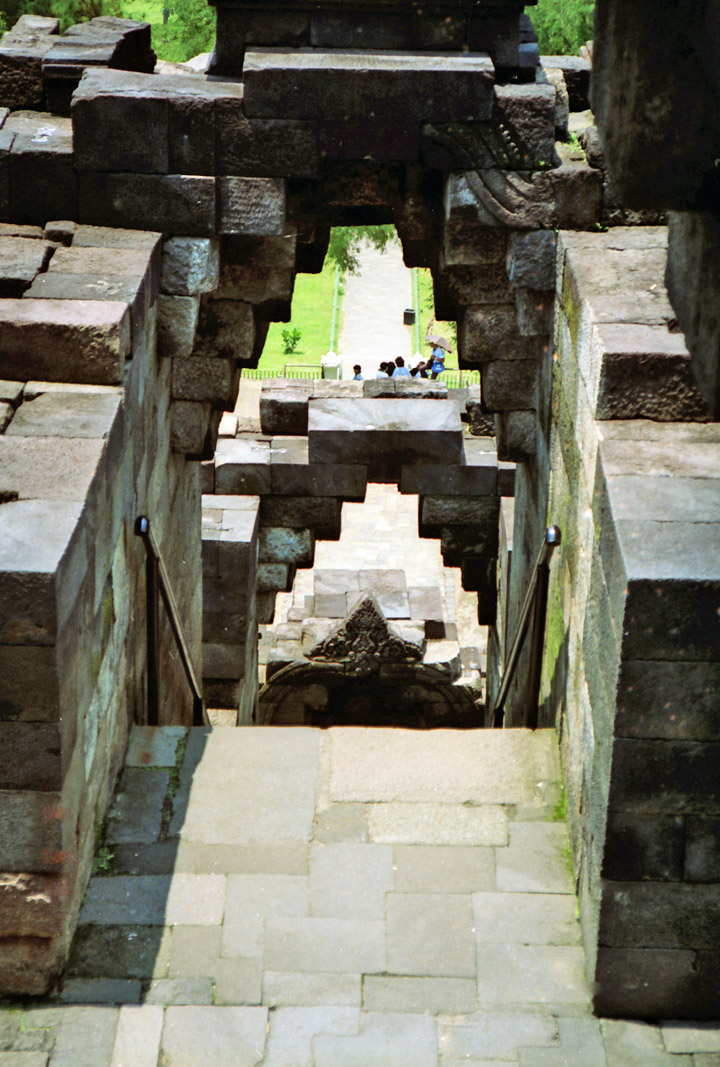
There is no written record of who built Borobudur or of its intended
purpose. The construction time has been estimated by comparison between
carved reliefs on the temple's hidden foot and the inscriptions commonly used in
royal charters during the eight and ninth centuries. Borobudur was likely
founded around 800 AD.[16] This corresponds to the period between 760–830 AD,
the peak of the Sailendra dynasty in central Java, when it was under the
influence of the Srivijayan Empire. The construction has been estimated to have
taken 75 years and been completed during the reign of Samaratungga in
825.
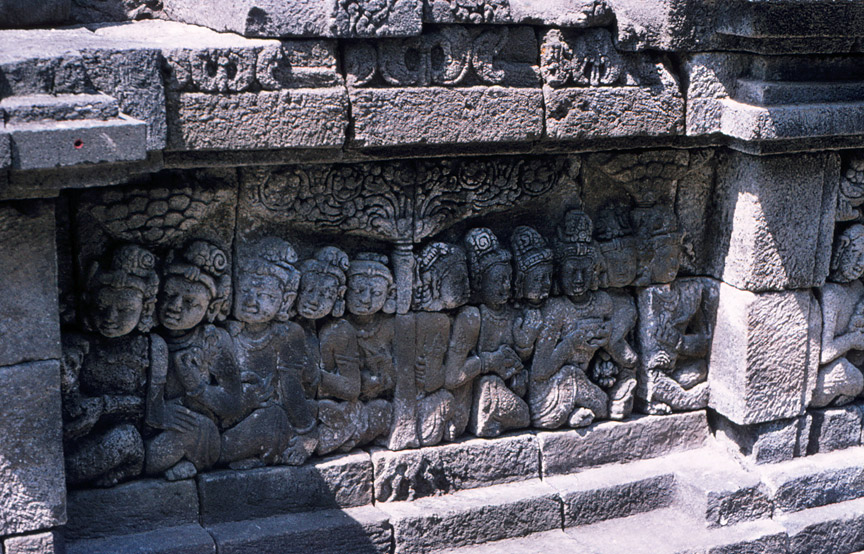
There is confusion between Hindu and Buddhist rulers in Java around that time.
The Sailendras were known as ardent followers of Lord Buddha, though stone
inscriptions found at Sojomerto suggest they may have been Hindus. It was
during this time that many Hindu and Buddhist monuments were built on the plains
and mountain around the Kedu Plain. The Buddhist monuments, including Borobudur,
were erected around the same time as the Hindu Shiva Prambanan temple compound.
In 732 AD, the Shivaite King Sanjaya commissioned a Shivalinga sanctuary to be
built on the Ukir hill, only 10 km (6.2 miles) east of Borobudur.
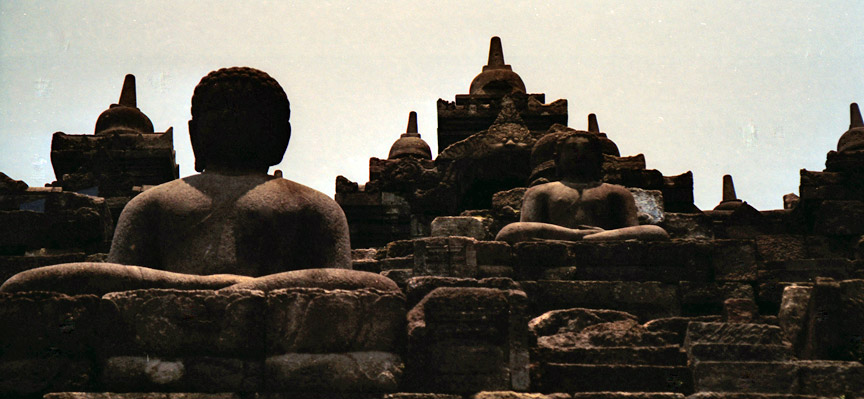
Construction of Buddhist temples, including Borobudur, at that time was possible
because Sanjaya's immediate successor, Rakai Panangkaran, granted his permission
to the Buddhist followers to build such temples. In fact, to show his
respect, Panangkaran gave the village of Kalasan to the Buddhist community, as
is written in the Kalasan Charter dated 778 AD. This has led some
archaeologists to believe that there was never serious conflict concerning
religion in Java as it was possible for a Hindu king to patronize the
establishment of a Buddhist monument; or for a Buddhist king to act
likewise. However, it is likely that there were two rival royal dynasties in
Java at the time—the Buddhist Sailendra and the Saivite Sanjaya—in which the
latter triumphed over their rival in the 856 battle on the Ratubaka plateau.
This confusion also exists regarding the Lara Jonggrang temple at the Prambanan
complex, which was believed that it was erected by the victor Rakai Pikatan as
the Sanjaya dynasty's reply to Borobudur, but others suggest that there was
a climate of peaceful coexistence where Sailendra involvement exists in Lara
Jonggrang.
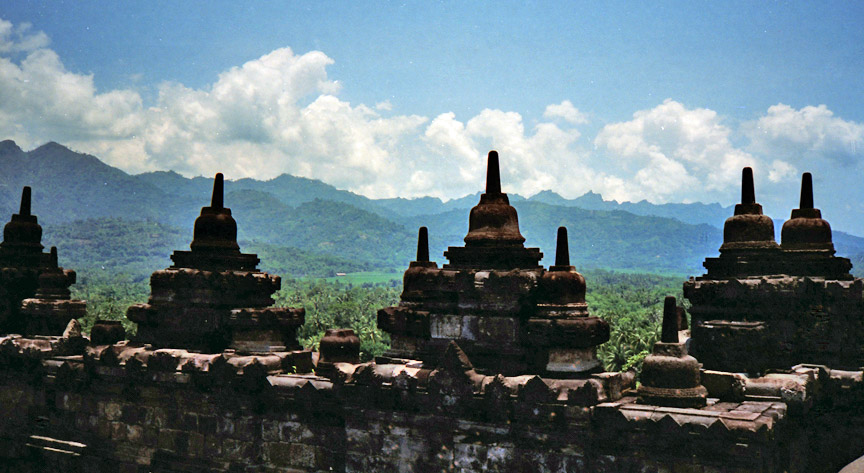
Borobudur lay hidden for centuries under layers of volcanic ash and jungle
growth. The facts behind its abandonment remain a mystery. It is not known when
active use of the monument and Buddhist pilgrimage to it ceased. Somewhere
between 928 and 1006, the center of power moved to East Java region and a series
of volcanic eruptions took place; it is not certain whether the latter
influenced the former but several sources mention this as the most likely period
of abandonment. Soekmono (1976) also mentions the popular belief that the
temples were disbanded when the population converted to Islam in the fifteenth
century.
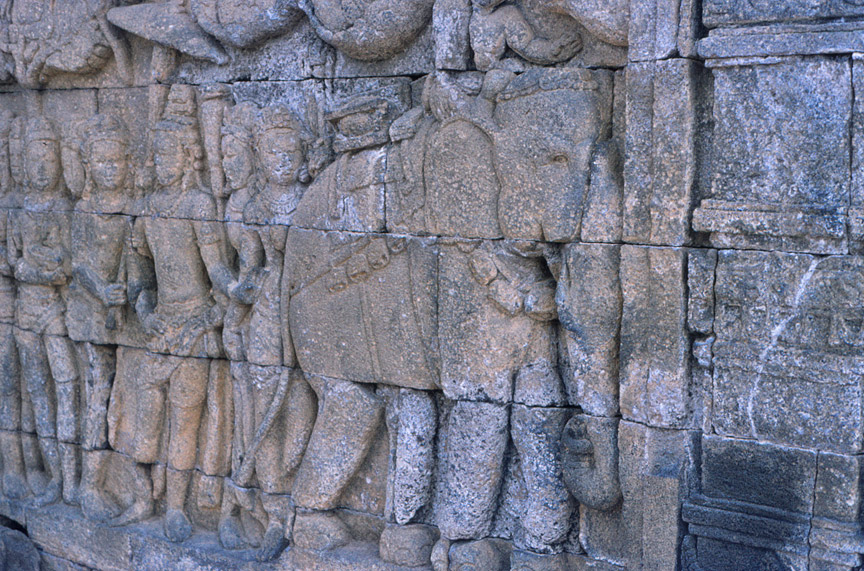
The monument was not forgotten completely, though folk stories gradually shifted
from its past glory into more superstitious beliefs associated with bad luck and
misery. Two old Javanese chronicles (babad) from the eighteenth century mention
cases of bad luck associated with the monument. According to the Babad Tanah
Jawi (or the History of Java), the monument was a fatal factor for a rebel who
revolted against the king of Mataram in 1709. The hill was besieged and the
insurgents were defeated and sentenced to death by the king. In the Babad
Mataram (or the History of the Mataram Kingdom), the monument was associated
with the misfortune of the crown prince of the Yogyakarta Sultanate in 1757.
In spite of a taboo against visiting the monument, "he took what is written as
the knight who was captured in a cage (a statue in one of the perforated stupas)".
Upon returning to his palace, he fell ill and died one day later.r.
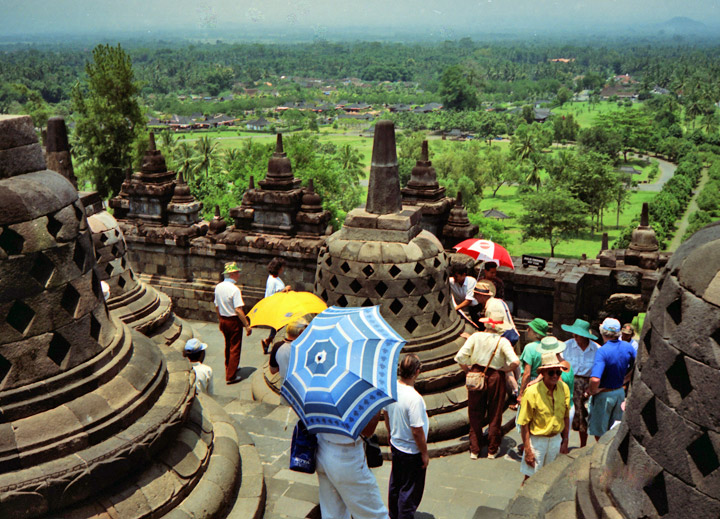
Following the Anglo-Dutch Java War, Java was under British administration from
1811 to 1816. The appointed governor was Lieutenant Governor-General Thomas
Stamford Raffles, who took great interest in the history of Java. He collected
Javanese antiques and made notes through contacts with local inhabitants during
his tour throughout the island. On an inspection tour to Semarang in 1814, he
was informed about a big monument deep in a jungle near the village of
Bumisegoro. He was not able to make the discovery himself and sent H.C.
Cornelius, a Dutch engineer, to investigate.
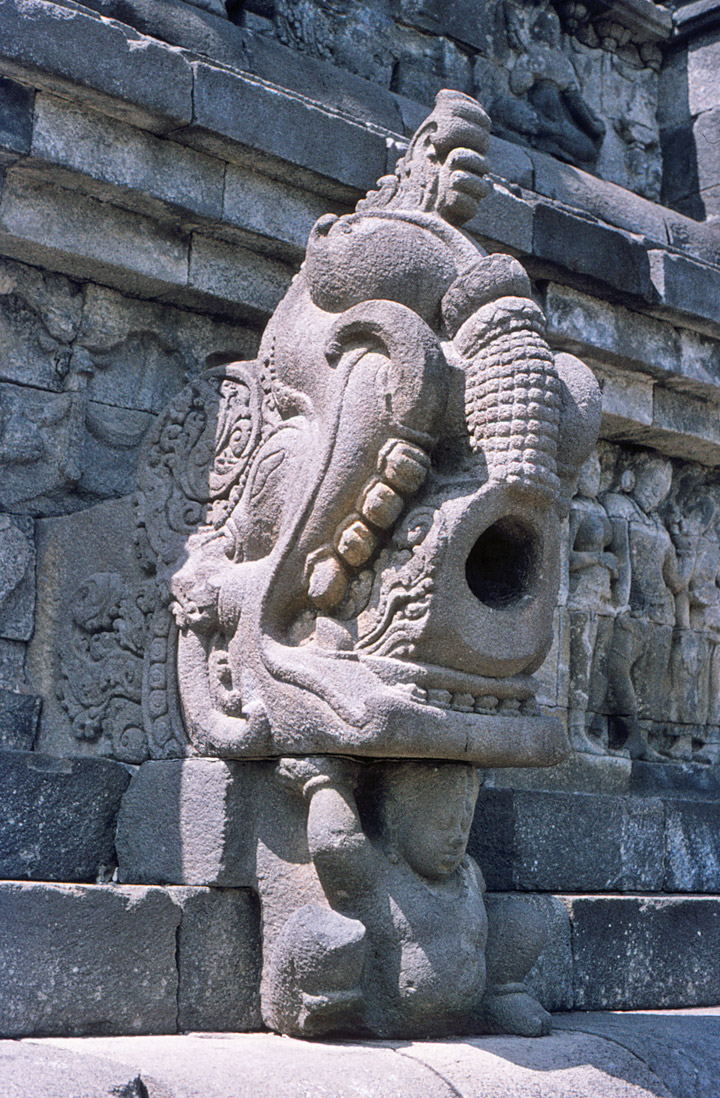
In two months, Cornelius and his 200 men cut down trees, burned down vegetation
and dug away the earth to reveal the monument. Due to the danger of collapse, he
could not unearth all galleries. He reported his findings to Raffles including
various drawings. Although the discovery is only mentioned by a few sentences,
Raffles has been credited with the monument's recovery, as one who had brought
it to the world's attention.
Hartmann, a Dutch administrator of the Kedu region, continued Cornelius' work
and in 1835 the whole complex was finally unearthed. His interest in Borobudur
was more personal than official. Hartmann did not write any reports of his
activities; in particular, the alleged story that he discovered the large statue
of Buddha in the main stupa. In 1842, Hartmann investigated the main dome
although what he discovered remains unknown as the main stupa remains empty.
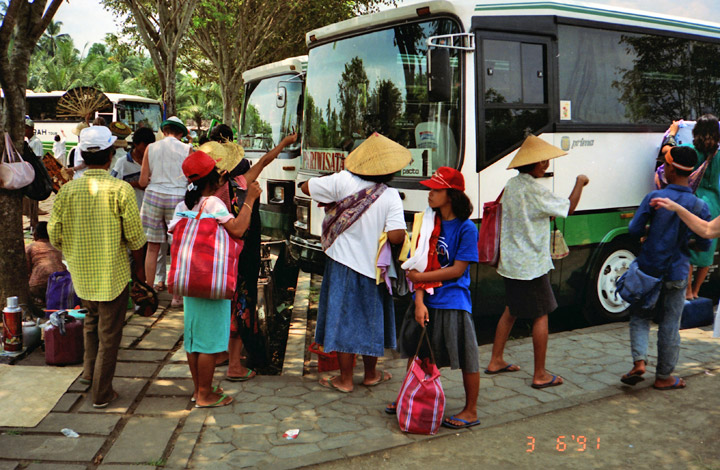
visitors
The Dutch East Indies government then commissioned F.C. Wilsen, a Dutch engineering official, who studied the monument and drew hundreds of relief sketches. J.F.G. Brumund was also appointed to make a detailed study of the monument, which was completed in 1859. The government intended to publish an article based on Brumund study supplemented by Wilsen's drawings, but Brumund refused to cooperate. The government then commissioned another scholar, C. Leemans, who compiled a monograph based on Brumund's and Wilsen's sources. In 1873, the first monograph of the detailed study of Borobudur was published, followed by its French translation a year later. The first photograph of the monument was taken in 1873 by a Dutch-Flemish engraver, Isidore van Kinsbergen.

Appreciation of the site developed slowly, and it served for some time largely
as a source of souvenirs and income for "souvenir hunters" and thieves. In 1882,
the chief inspector of cultural artifacts recommended that Borobudur be entirely
disassembled with the relocation of reliefs into museums due to the unstable
condition of the monument. As a result, the government appointed Groenveldt,
an archeologist, to undertake a thorough investigation of the site and to assess
the actual condition of the complex; his report found that these fears were
unjustified and recommended it be left intact.
Following the major 1973 renovation funded by UNESCO, Borobudur is once
again used as a place of worship and pilgrimage. Once a year, during the full
moon in May or June, Buddhists in Indonesia observe Vesak (Indonesian: Waisak)
day commemorating the birth, death, and the time when Siddhārtha Gautama
attained the highest wisdom to become the Buddha Shakyamuni. Vesak is an
official national holiday in Indonesia and the ceremony is centered at the
three Buddhist temples by walking from Mendut to Pawon and ending at Borobudur.
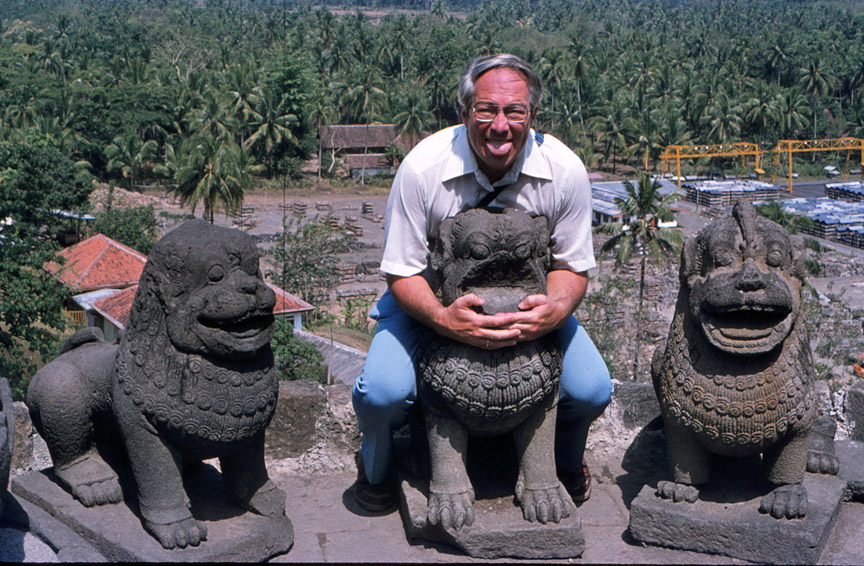
"The Traveler" imitating one of the lions
The monument is the single most visited tourist attraction in Indonesia. In
1974, 260,000 tourists of whom 36,000 were foreigners visited the monument.
The figure hiked into 2.5 million visitors annually (80% were domestic tourists)
in the mid 1990s, before the country's economy crisis. Tourism development,
however, has been criticized for not including the local community on which
occasional local conflict has arisen. In 2003, residents and small businesses
around Borobudur organized several meetings and poetry protests, objecting to a
provincial government plan to build a three-story mall complex, dubbed the 'Java
World'.
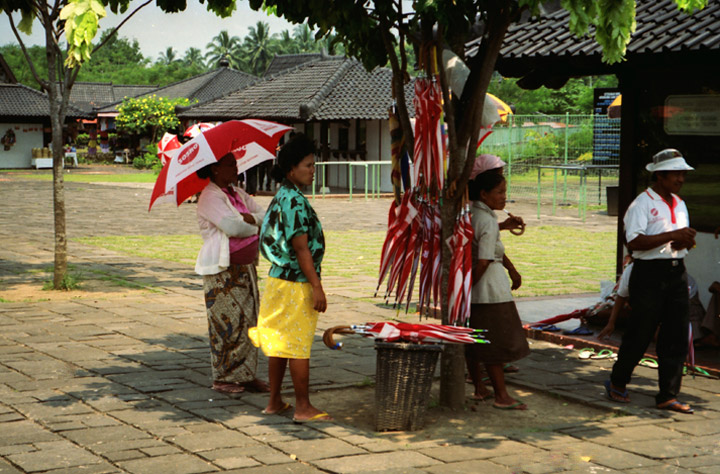
On 21 January 1985, nine stupas were badly damaged by nine bombs. In 1991, a
blind Muslim evangelist, Husein Ali Al Habsyie, was sentenced to life
imprisonment for masterminding a series of bombings in the mid 1980s including
the temple attack. Two other members of a right-wing extremist group that
carried out the bombings were each sentenced to 20 years in 1986 and another man
received a 13-year prison term. On 27 May 2006, an earthquake of 6.2 magnitude
on the Richter scale struck the south coast of Central Java. The event had
caused severe damage around the region and casualties to the nearby city of Yogyakarta, but Borobudur remained intact.
Text from Wikipedia